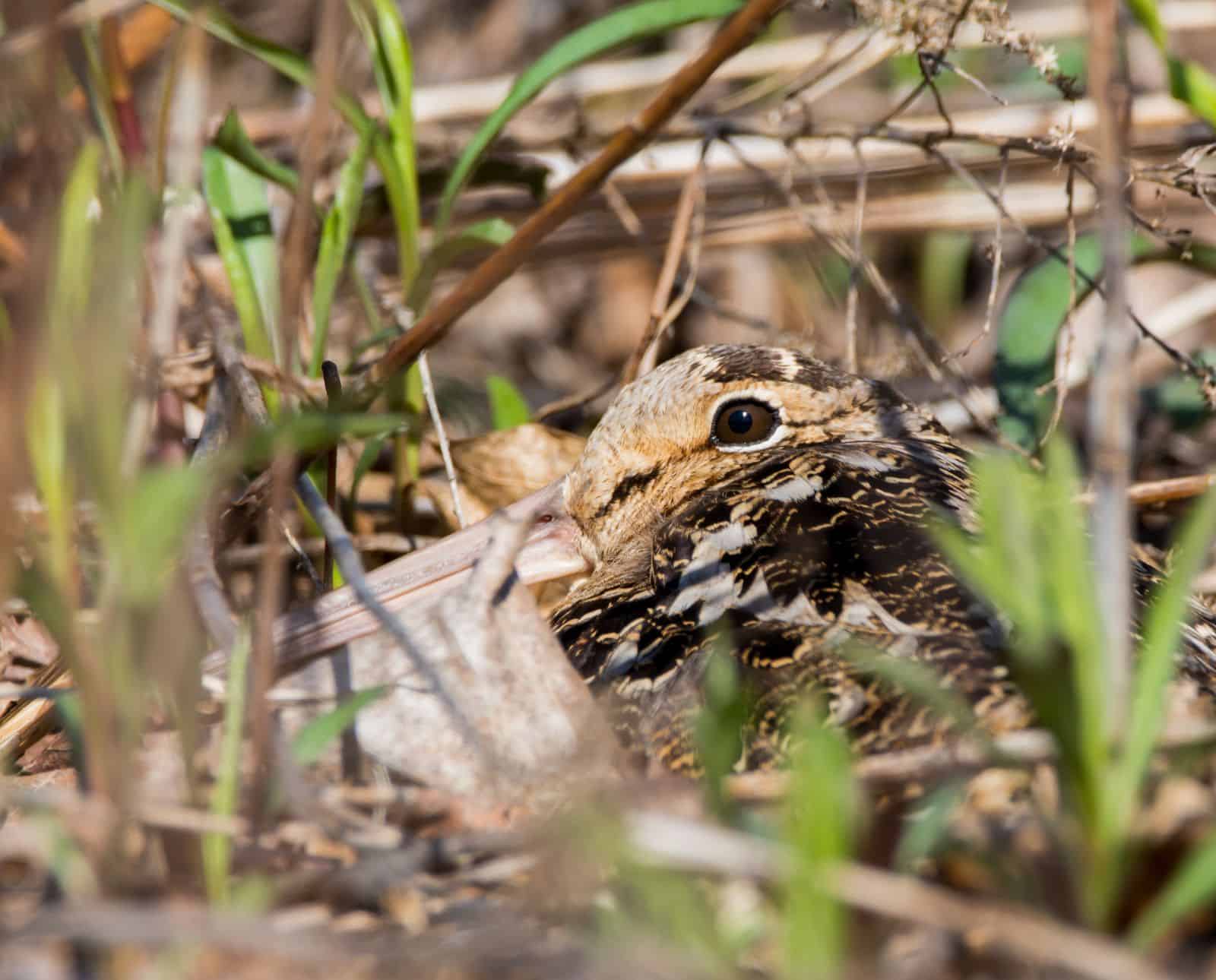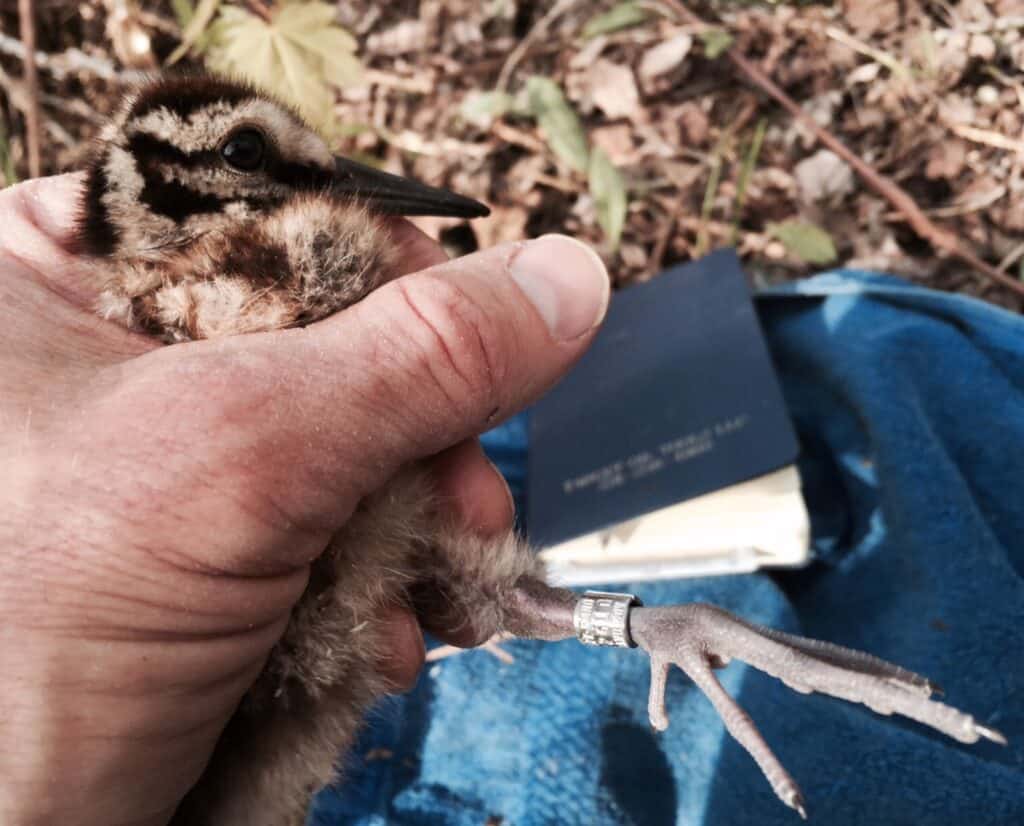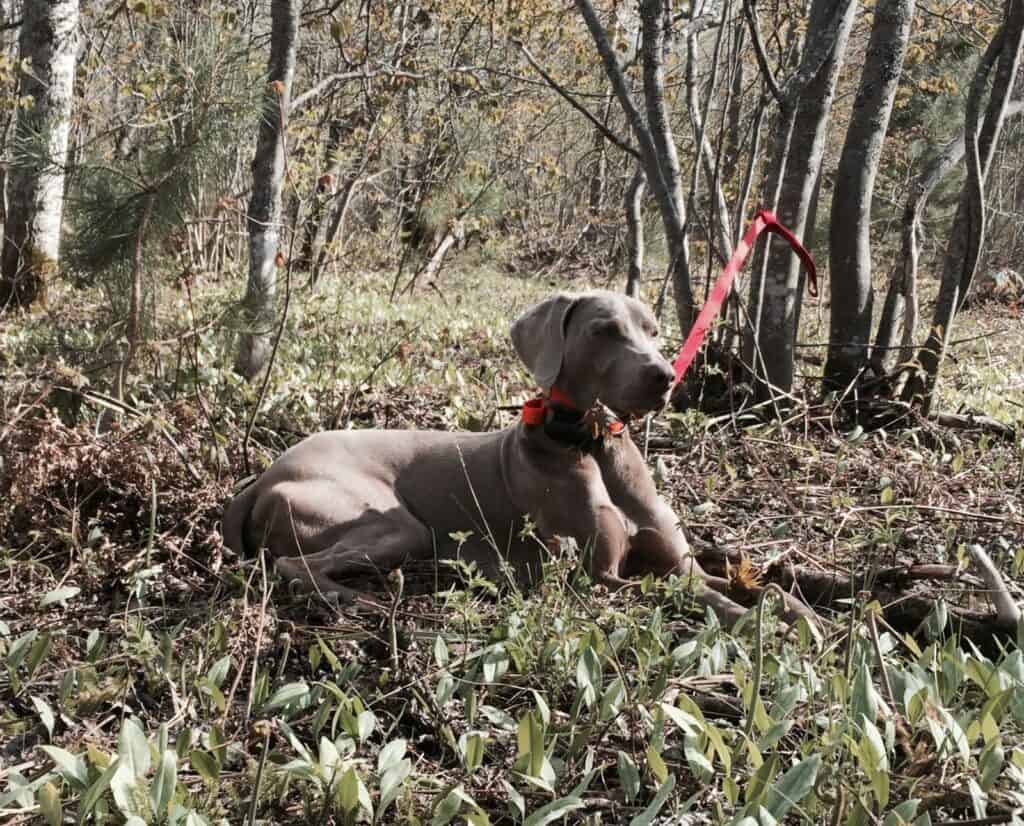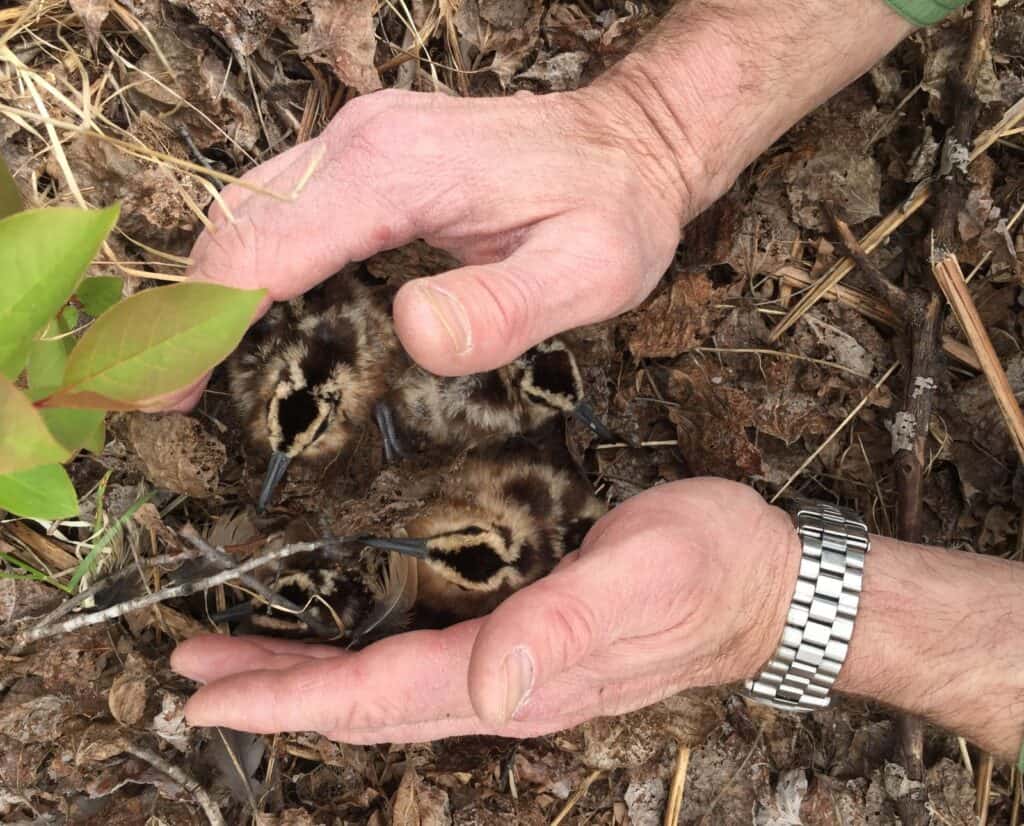Home » Woodcock Hunting » Dogs Are The Means: Banding American Woodcock in Michigan
Dogs Are The Means: Banding American Woodcock in Michigan

Gabby Zaldumbide is Project Upland's Editor in Chief. Gabby was…
Banding American woodcock in Northern Lower Michigan wouldn’t be feasible without the help of pointing dogs.
This article originally appeared in Hunting Dog Confidential Volume 5. The Michigan Woodcock Banding Program is permitted by the Michigan DNR-Wildlife Division and the USGS-Bird Banding Laboratory to capture and band woodcock.
On a bright April morning in northern Michigan, a devoted uplander embarks upon a spring ritual with his proofed Weimaraner. Soft, damp leaves give way under his bootsteps as the silver dog works the budding hardwood forest before him. Suddenly, the large dog halts, his muscles frozen with the isometric pressure required to point. He holds steady, allowing his handler to walk up beside him.
The man is looking for a hen American woodcock holding tight in front of his pointing dog. After scouring the ground for the highly camouflaged bird, he spots her perfectly still body in the leaf litter near a short, bare seedling. He leashes his dog, heels the Weimaraner away, and ties him to a nearby tree. Then, he removes an expandable fishing net from his pack and returns to the hen. The hen is collected gently and placed in a soft, zippered mesh bag.
Then, he begins looking for the highly concealed chicks. With bodies the size of cotton balls adorned with downy feathers intended to mimic fallen leaves, American woodcock chicks are incredibly difficult to locate. During the search, he takes slow, careful steps, taking the utmost caution not to step on a fragile chick.
There! He spots one. The man drops a metal washer with hot pink tape wrapped around it next to the tiny, motionless bird to mark its location. There’s another! He sets down another chip. There are four chicks in total; this hen laid a perfectly average clutch size. After all of the chicks are located, he begins gathering the small birds by hand. The first chick to be captured peeps out a warning, and the remaining chicks on the ground begin darting in every direction. The man does his best to quickly, safely, quietly, nab each chick and reunite them in their own mesh garment bag.
He returns to his gear pile and the trapped hen. The leashed dog gives him a curious look as he removes banding pliers and five minuscule leg bands from his pack. He bands the hen first because she’s been held captive for the longest, then releases her.* Then, he fits each chick with their own leg band. After every bird is outfitted with a new piece of jewelry, they are clustered together on the ground. With his hands placed over the gathered chicks, the man simulates a hen’s flush and then quickly leaves the chicks to await the hen’s return.
He releases the dog from the tree. Once the pair is a safe distance away from the woodcock family, the dog is unleashed and encouraged to search for another unsuspecting brood.
This man’s name is Bill Quinlan. He is a permitted woodcock bander in Michigan. Each spring, he takes his most reliable and skilled bird dog into the woods in search of woodcock. Prior to being a bander, Quinlan utilized early spring days prior to the nesting quiet period to train his dogs on grouse and returning flight birds. He’d take his pups into places where the snow recedes first, hiking down open areas and utility lines to work cover.
He loves being in the woods this time of the year because the trees have no leaves. Air and scent travel freely through these usually dense, wooded areas, making it easier for dogs’ noses to pick up bird scent.
Those springtime treks got Quinlan thinking about woodcock banding.

Becoming A Permitted Woodcock Bander in Michigan
“Contemplating about these birds and their migration, habits, and sky dances got me thinking about how I might apply my pursuit of upland dog training to help aid with the viability of the American woodcock,” said Quinlan. “As such, I decided I wanted to pursue banding woodcock.” Thankfully, he knew someone in his northern Michigan NAVHDA chapter who was a permitted bander. Quinlan apprenticed with him for two seasons before being officially permitted through Michigan’s banding program himself.
After Quinlan decided he wanted to be a bander, he needed to get his dogs up to snuff, too. “It is absolutely a requirement to have a steady dog to engage in woodcock banding. As an apprentice, your dog needs to be judged by your mentor. To be a plausible woodcock banding dog, your dog must be steady in the presence of game,” said Quinlan. “At a minimum, I want my dogs to be steady through flush, preferably through shot.”
Once you are a licensed bander, you are responsible for judging whether your own dog is ready. If your dog might break on a hen or chick, he must be kept out of the nesting woods until the proper level of steadiness is attained through further training. “If your dog is steady to shot, he’s a level or so beyond what will be encountered during banding,” said Quinlan.
Dogs Used For Banding Woodcock Must Meet Certain Standards
Quinlan’s goal is to train for NAVHDA Prize I utility dogs. He’s found that NAVHDA’s utility training is the flagship program for creating great versatile dogs. “I found it so useful in terms of my hunting and training versatile dogs like the Weimaraner,” said Quinlan. This rigorous training program helps Quinlan’s dogs perform above and beyond what is required of the minimum woodcock banding standards.
Obviously, Quinlan isn’t doing any springtime hunting, but he helps reinforce the steady-to-shot expectation during early spring training by packing along a blank handgun and blank rounds. Before Michigan’s nesting quiet period begins, he tunes up Panzer, his oldest Weimaraner, by training him on ruffed grouse and returning woodcock flight birds. That way, Panzer is reacquainted with Quinlan’s expectations and is mentally ready to help him band woodcock chicks come late April.
It’s easy to see how woodcock banding is a task reserved for well-trained and steady pointing dogs. American woodcock chicks are incredibly small and easily crushed; a dog that may step on a chick or, heaven forbid, catch one has no place pointing broods. Instead, banding is reserved for proofed dogs who can be trusted, and whose expertise is unquestionable. For example, Panzer’s son, Rogue, is Quinlan’s puppy in training. Rogue isn’t quite ready to help band woodcock yet, but if he’s anything like his father, he will be before Quinlan knows it.
Woodcock Banding Would Be Nearly Impossible Without Dogs
Arguably, pointing dogs are required to successfully conduct woodcock banding projects. While it’s not impossible to stumble across broods alone, dogs are invaluable partners when trying to locate camouflaged hens and chicks.
“Dogs are the means of finding birds. They are indispensable,” said Quinlan.
When you get down to the meat of what makes a good woodcock banding dog, those same traits are exactly what makes a good upland hunting dog. “First and foremost is prey drive,” said Quinlan. Sniffing out hens and broods is a finding game to hunting dogs, and banding dogs must be driven to locate woodcock. “A dog that’s intelligent on searching cover using the wind, has a drive that gets him out and away, and is steady when you reach him would be a great banding dog,” he said.

Banding Woodcock Helps Biologists Understand These Birds
If you’re looking to spend more of spring in the woods, consider becoming a permitted woodcock bander. Several states have obtained a master permit from the U.S. Fish and Wildlife Service to conduct woodcock banding projects. Those states are allowed to sub-permit private citizens to band woodcock on their own. States that do so have contributed to a wealth of data regarding woodcock populations, behaviors, and movements.
“The data generated from this work is used to make decisions on bag limits, hunting season durations, and more,” said Quinlan. The data Quinlan is talking about includes brood size, approximate age, and GPS location.
“Bird banding began in the late 1800s as a way of collecting data about age, sex, survival, and spatial distribution of migratory game birds,” writes Bailey Petersen, an assistant wildlife area manager with the Minnesota DNR. “When a band is reported to the U.S. Geological Survey’s Bird Banding Laboratory in Maryland, the program is able to see where the bird was harvested or recaptured in relation to where it was originally caught. Additional data collected during banding, such as age and sex, can be used to determine differences in migration patterns and survival among cohorts as well as the current age of the bird.”
Woodcock Banding Is A Part Of Michigan’s Culture
According to the Michigan DNR’s “Ruffed Grouse And American Woodcock Status In Michigan, 2019,” 74 Michigan banders spent 2,052 hours in the field and banded 1,110 woodcock chicks. Impressively, since 1981, Michigan has out-banded all other states and Canada by 40,000 birds.
Michigan has a robust banding culture for a good reason: Dr. Andy Amman. Amman, a renowned ruffed grouse and American woodcock researcher, began banding woodcock with dogs in the 1960s. After using English Pointers, English Setters, and Brittanys to develop his techniques, he published a book with The Ruffed Grouse Society in 1981 titled A Guide to Capturing and Banding American Woodcock Using Pointing Dogs. Inside are remarks about the wonders of working with bird dogs, how to use specialized pliers to open and close leg bands, and details on handling woodcock chicks.
Amman’s model for using a pointing dog to locate woodcock hens and chicks flourished. Today, the 34-page guide influenced the methods for Michigan’s, Minnesota’s, and Wisconsin’s state-run woodcock banding programs.

Woodcock Populations Are Declining
The Michigan DNR is aware that woodcock populations are declining. The most significant cause is likely due to a decrease in quality habitat. “Ruffed Grouse And American Woodcock Status In Michigan, 2019” states, “Game population surveys have indicated woodcock populations are currently among their lowest recorded levels since the 1960s.” That said, “federal surveys show that Michigan is still the number one state in the country for American woodcock harvest and one of the top production states.”
The U.S. Fish and Wildlife Service’s “American Woodcock Population Status, 2023” by Mark Seamans and Rebecca Rau came to similar conclusions. According to its authors, Central Region woodcock are declining at a rate of 1.25 percent annually. They also found that the region’s 2022 recruitment rate index was 18.2 percent less than the 2021 index. In 2022, there were only 1.23 immature woodcock for every adult female.
Loss of habitat quality is likely a significant cause of woodcock population declines. As human developments expand, fires are suppressed, and forests are permitted to grow into older age classes, young and disturbed forests are becoming harder to come by. Woodcock rely on these early successional habitats for food and cover.
Woodcock research utilizing a wide range of techniques, and focusing on all woodcock, including females and chicks, is necessary to help managers key in on what can be done to have the most impact on woodcock populations. Banders are at a unique advantage because they can use bird dogs to locate nesting females and broods. Banders can provide valuable information through their efforts and can aid in other forms of research, such as radio telemetry and habitat analysis.
Become A Woodcock Bander, Volunteer With Your State Wildlife Agency
It’s worth noting that while Wisconsin, Minnesota, and Louisiana may be looking for more woodcock banders, Michigan is essentially tapped out. The Michigan DNR stated they already have a surplus of banders. Before becoming a woodcock bander, it’s recommended that you give your state agency a call and see if they could use more help.
If you do decide to volunteer with your state wildlife agency, then you, like Quinlan, can use these springtime adventures to learn more about woodcock habitat and where to concentrate your hunting efforts in the fall. “Spring is a great time to be in the woods,” said Quinlan. “I always use spring as an opportunity to get back into dog training for the year. As soon as we can get out into the cover in the areas we can hunt, we do.”
“Those who use well-trained pointing dogs in search of broods will derive considerable pleasure from watching their dogs work,” Dr. Amman writes. “Additionally, the bander will be captivated by the antics of the hen and her chicks and all of the other things he will discover for himself about these fascinating birds.” Ask any woodcock bander about why they do what they do, and I’m certain they’ll echo Dr. Amman’s and Quinlan’s remarks.
*As of March 31, 2024, banders in Michigan no longer band hen woodcock to reduce the amount of stress they endure during the brood rearing season.
Gabby Zaldumbide is Project Upland's Editor in Chief. Gabby was born in Maryland and raised in southern Wisconsin, where she also studied wildlife ecology at the University of Wisconsin-Madison. In 2018, she moved to Gunnison, Colorado to earn her master's in public land management from Western Colorado University. Gabby still lives there today and shares 11 acres with eight dogs, five horses, and three cats. She herds cows for a local rancher on the side.



